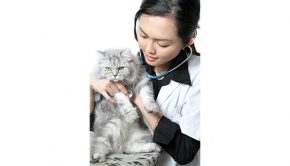Pet Anesthesia
How to Make It Safe and Easier on Everyone
Many pet parents and some veterinarians have an unnecessary fear of animal anesthesia. Addressing some misconceptions about this common medical procedure can be helpful, particularly in regard to older pets.
Myth #1: Anesthesia is Dangerous
Modern anesthesia has evolved into a safe medical practice since it was introduced in 1799 and uses much safer drugs than earlier versions. Still, all medications need to be approached cautiously for the welfare of all individuals connected to its use. Both injectable anesthetic drugs and inhalant anesthetic drugs (gases) can be used safely if properly chosen for a specific condition, accurately dosed and continuously monitored.
Myth #2: Grogginess is a Given
When a high-quality medication is properly administered, a groggy state lasting from several hours to a day or more following a procedure shouldn’t occur. Lower-quality anesthetic drugs injected during discounted spaying and neutering procedures may produce such prolonged recovery periods.
It’s safer to use a high quality quick-acting short-term injectable anesthetic, followed by gas anesthesia for anesthetic maintenance, during surgical procedures, including for spaying and neutering. Patients wake up quickly following surgery and can be sent home fully awake soon afterwards.
Myth #3: A Pet is Too Old
No pet is too old for proper medical care. Because older pets don’t metabolize some drugs as well as younger ones, the correct anesthesia must be chosen for the pet’s age and current state of health or medical problems. Too often, pets haven’t received proper care, especially dental cleanings and tumor removals, because their current veterinarian has deemed them too old for anesthesia.
Both the family and the veterinarian need to feel comfortable with treatments. Ask questions before submitting an animal to any anesthetic, surgical or medical procedure. Talk with the veterinarian about using this gentle, natural approach to help relieve any concerns if a pet needs sedation or anesthesia.
Shawn Messonnier, a doctor of veterinary medicine practicing in Plano, TX, is the award-winning author of The Natural Health Bible for Dogs & Cats and Unexpected Miracles: Hope and Holistic Healing for Pets. For more information, visit PetCareNaturally.com.
Principles of Holistic Anesthesia
- Each patient is unique and has unique anesthetic needs.
- Giving the least amount of anesthesia needed ensures the safest possible procedure.
- Analgesics are used to minimize discomfort and meet anesthetic needs.
- Some anesthetic drugs may be used to minimize the depth of anesthesia obtained.
- Light levels of anesthesia are preferred for minimally painful procedures.
- Carefully monitoring the patient during anesthesia helps ensure a good outcome.
- Patients should wake up from anesthesia immediately following the procedure.
- Patients are sent home immediately following anesthetic recovery.
- An older pet can be safely anesthetized by a holistic vet as part of its anti-aging care.
<












